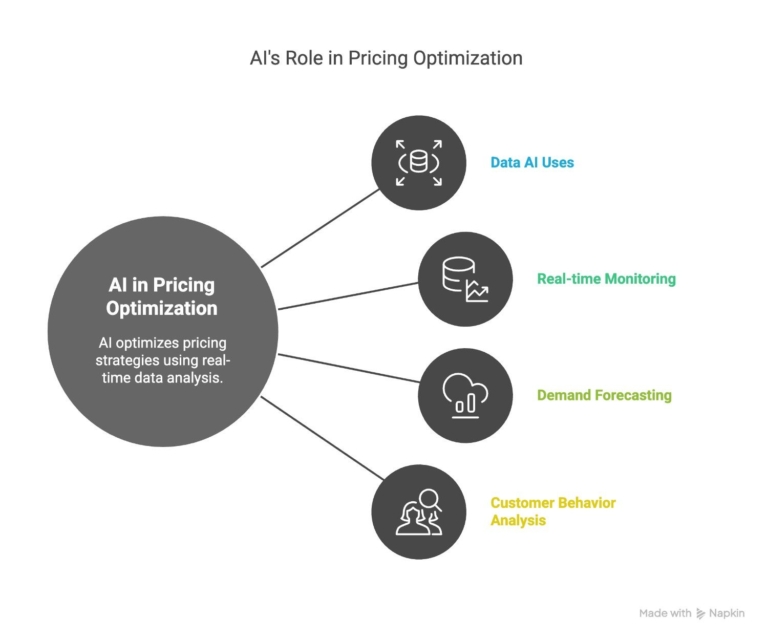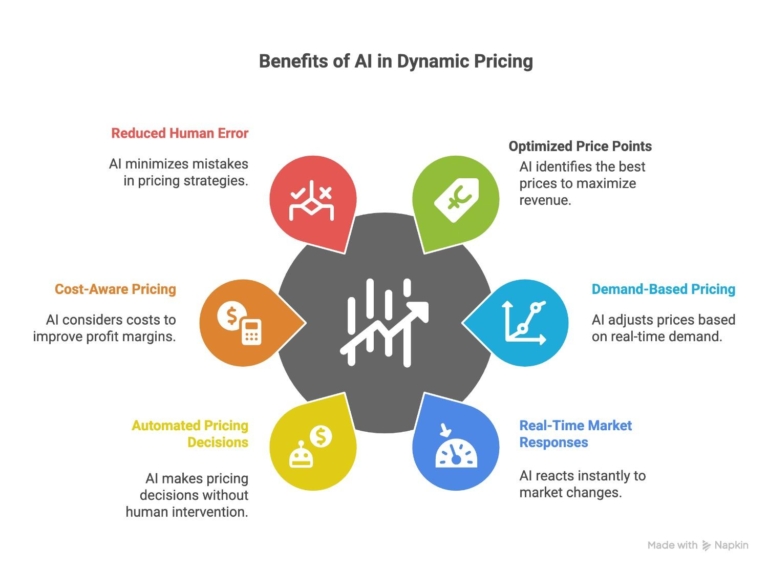Greetings! I'm Aneesh Sreedharan, CEO of 2Hats Logic Solutions. At 2Hats Logic Solutions, we are dedicated to providing technical expertise and resolving your concerns in the world of technology. Our blog page serves as a resource where we share insights and experiences, offering valuable perspectives on your queries.

Have you ever wondered how Amazon manages to change prices millions of times per day?
The answer is AI-powered dynamic pricing. Online retailers no longer have to stuck with static price tags.
These intelligent systems can automatically adjust prices based on real-time data to maximize revenue and stay competitive. This technology has moved from being a luxury to an essential tool for businesses of all sizes.
What is AI-based dynamic pricing?
AI dynamic pricing is a strategy that uses artificial intelligence and machine learning algorithms. Using these technologies it can adjust product prices in real-time. When it comes to traditional pricing methods , you have to set a price. In AI dynamic pricing it will continuously analyzes multiple data points to find the optimal price for each product at any given moment.
How AI dynamic pricing differs from traditional pricing methods
Traditional pricing typically follows these approaches:
- Cost-plus pricing: Add a markup to your product cost
- Competitive pricing: Match or slightly undercut competitor prices
- Value-based pricing: Price based on perceived customer value
- Fixed pricing: Set prices and review them quarterly or annually
Dynamic pricing software changes this method completely. Instead of manual price reviews, AI algorithms process thousands of data points every minute and make pricing decisions faster than any human could. The system considers competitor prices, demand fluctuations, inventory levels, customer behavior, seasonality, and dozens of other factors simultaneously.
Is it right for your business size and type?
AI dynamic pricing works best for businesses with:
- 100+ products in their catalog
- Competitive markets with frequent price changes
- Seasonal demand fluctuations
- Multiple sales channels
- Sufficient transaction data (at least 50 sales per month per product)
It’s particularly effective for:
- Fashion and apparel
- Electronics and gadgets
- Home goods and furniture
- Automotive parts
- Books and media
- Seasonal products
Curious how this could work for your store? We’ll take a look at your pricing and show you the possibilities.
However, it might not be suitable for:
- Luxury brands focused on premium positioning
- Custom or made-to-order products
- Markets with very stable pricing
- Businesses with fewer than 50 products
How does AI optimize pricing strategies?
AI pricing optimization works by processing vast amounts of data that would be impossible for humans to analyze manually. Here’s how the technology makes smarter pricing decisions:

The data AI uses to make pricing decisions
Modern automated pricing tools analyze multiple data streams simultaneously:
Internal data sources:
- Historical sales data and trends
- Current inventory levels and turnover rates
- Product costs and desired profit margins
- Customer purchase history and behavior
- Seasonal performance patterns
External data sources:
- Competitor pricing across multiple channels
- Market demand indicators
- Industry trends and news
- Economic factors and consumer spending data
- Social media sentiment and product buzz
Real-time factors:
- Current website traffic and conversion rates
- Time of day and day of week patterns
- Geographic location and local market conditions
- Weather data for seasonal products
- Current promotional campaigns and their performance
Real-time competitor monitoring and market analysis
One of the biggest advantages of dynamic pricing software is its ability to monitor competitors 24/7. The AI tracks:
- Price changes across all major competitors
- New product launches and their pricing strategies
- Promotional campaigns and discount patterns
- Stock availability and out-of-stock situations
- Market positioning changes
This real-time pricing strategy means you’re never caught off guard by competitor moves. If a major competitor drops prices on a popular item, your system can respond within minutes rather than days or weeks.
Demand forecasting and inventory considerations
Machine learning pricing algorithms excel at predicting future demand based on:
- Historical sales patterns
- Seasonal trends and cyclical behavior
- External factors like weather, events, or holidays
- Marketing campaign performance
- Economic indicators and consumer confidence
This demand forecasting directly influences pricing decisions. When the AI predicts high demand, it can gradually increase prices to maximize revenue. When demand is expected to be low, it can lower prices to maintain sales velocity and clear inventory.
Customer behavior patterns and purchase history
AI analyzes individual customer behavior to optimize pricing:
- Price sensitivity analysis: Understanding which customers are more likely to buy at different price points
- Purchase timing patterns: Identifying when customers typically make buying decisions
- Cross-selling opportunities: Pricing complementary products to maximize basket value
- Customer lifetime value: Adjusting prices based on long-term customer relationships
6 Key benefits of AI in dynamic pricing

1. Increased revenue through optimized price points
The most significant benefit of AI dynamic pricing is revenue growth. By finding the optimal price point for each product at each moment, businesses typically see:
- 15-25% revenue increase within the first year
- Better pricing during peak demand periods
- Improved conversion rates on properly priced items
- Higher average order values through strategic pricing
2. Better inventory management with demand-based pricing
Dynamic pricing software helps solve inventory challenges:
- Overstock situations: Automatically reduce prices to clear slow-moving inventory
- Understock scenarios: Increase prices to manage demand when supply is limited
- Seasonal transitions: Smoothly transition between seasonal pricing patterns
- Product lifecycle management: Optimize pricing as products move through their lifecycle
3. Competitive advantage through real-time market responses
While competitors manually adjust prices weekly or monthly, your AI pricing optimization system responds in real-time:
- Instant reaction to competitor price changes
- Automatic adjustment during competitor stockouts
- Dynamic response to market conditions
- Proactive pricing before competitors can react
4. Time savings from automated pricing decisions
Manual pricing management consumes enormous amounts of time. Automated pricing tools eliminate:
- Hours spent checking competitor prices
- Complex spreadsheet calculations
- Manual price updates across multiple channels
- Time-consuming analysis of pricing performance
This time savings allows you to focus on strategy, marketing, and business growth instead of operational pricing tasks.
5. Improved profit margins with cost-aware pricing
AI doesn’t just optimize for revenue – it can optimize for profit margins by:
- Factoring in real-time cost changes
- Maintaining minimum margin requirements
- Identifying high-margin opportunities
- Balancing volume and margin optimization
6. Reduced human error in pricing strategy execution
Manual pricing leads to mistakes that can be costly:
- Accidentally pricing below cost
- Missing competitor price changes
- Inconsistent pricing across channels
- Delayed responses to market conditions
AI dynamic pricing eliminates these errors through automated, data-driven decisions.
Custom solutions: When to build your own system
Consider custom AI dynamic pricing development when:
- You have unique business requirements
- Existing tools don’t integrate with your systems
- You need specific industry features
- You want complete control over algorithms
- You have the budget for custom development ($50K+)
Get expert advise on custom solutions
Future-proofing your pricing strategy with AI
Emerging trends in AI pricing technology
The future of AI dynamic pricing includes:
- Predictive analytics: Better demand forecasting using external data
- Personalized pricing: Individual customer pricing based on behavior
- Voice commerce integration: Pricing optimization for voice shopping
- Augmented reality pricing: Dynamic pricing in AR shopping experiences
- Blockchain transparency: Verifiable pricing algorithms for trust
How machine learning improves over time
AI pricing optimization gets smarter through:
- Continuous learning from pricing decisions and outcomes
- Improved pattern recognition in customer behavior
- Better integration of external data sources
- Enhanced competitor analysis capabilities
- More sophisticated demand forecasting
Preparing for changing consumer expectations
Consumer expectations are evolving:
- Demand for personalized pricing experiences
- Increased price transparency expectations
- Real-time price matching requests
- Multi-channel pricing consistency demands
- Sustainability and ethical pricing considerations
Scaling your pricing strategy as you grow
Plan for growth with scalable dynamic pricing software:
- Choose tools that grow with your business
- Implement flexible pricing architectures
- Plan for international expansion pricing needs
- Consider multi-brand pricing management
- Prepare for increased complexity and sophistication
Getting started with professional implementation
When to consider custom AI pricing solutions
Custom development makes sense when:
- Your business has unique pricing requirements
- Existing tools lack necessary features
- You need deep integration with proprietary systems
- You want competitive advantage through proprietary algorithms
- You have the budget and timeline for custom development
Conclusion
AI dynamic pricing has evolved from a competitive advantage to a business necessity for online retailers. The technology offers significant benefits including increased revenue, better inventory management, and reduced manual pricing work. However, success requires careful planning, proper tool selection, and ongoing optimization.
With the right approach and tools, businesses of all sizes can utilize AI to optimize their pricing strategies. Contact 2Hats Logic Solutions for a free consultation on implementing AI dynamic pricing for your e-commerce business.

Related Articles







